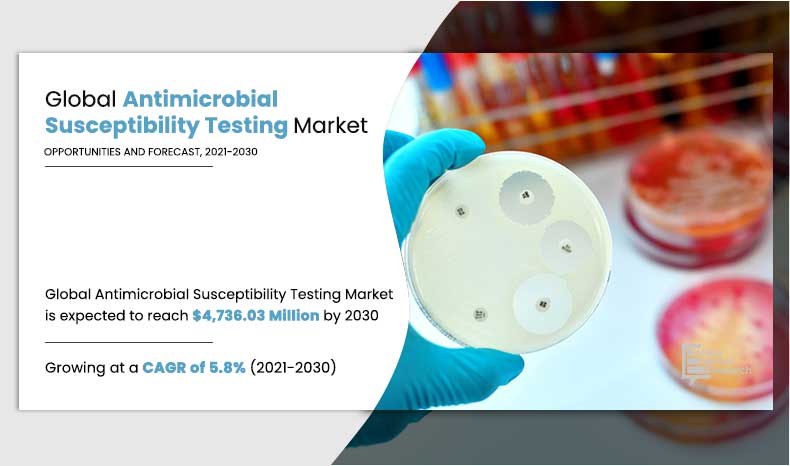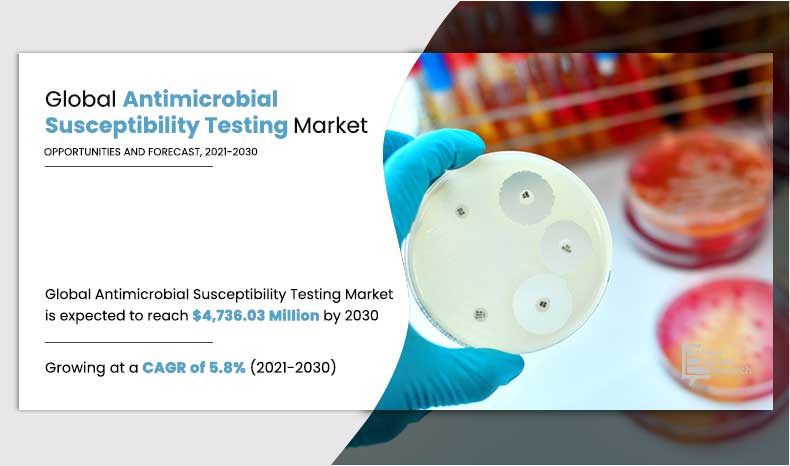
The global antimicrobial susceptibility testing market was valued at $3,040.00 million in 2020, and is estimated to reach $4,736.03 million by 2030, growing at a CAGR of 5.8% from 2021 to 2030., driven by the increasing prevalence of antibiotic resistance and the need for effective treatment strategies.
CAGR: 5.8%
Current Market Size: USD 3.04 Billion
Forecast Growing Region: APAC
Largest Market: North America
Projection Time: 2021 – 2030
Base Year: 2021
𝐑𝐞𝐪𝐮𝐞𝐬𝐭 𝐑𝐞𝐩𝐨𝐫𝐭 𝐒𝐚𝐦𝐩𝐥𝐞 𝐂𝐨𝐩𝐲 𝐇𝐞𝐫𝐞-
https://www.alliedmarketresearch.com/request-sample/10647
In the battle against infectious diseases, antimicrobial susceptibility testing (AST) plays a crucial role in guiding clinicians to select the most effective antibiotics for treating patients. Traditional AST methods have served us well for many years, but the rise of antimicrobial resistance has highlighted the need for faster, more accurate, and innovative testing technologies. This article delves into the exciting realm of emerging technologies and innovations in the antimicrobial susceptibility testing market, which offer hope for more precise and personalized treatment strategies.
- MALDI-TOF Mass Spectrometry
Matrix-Assisted Laser Desorption/Ionization Time-of-Flight (MALDI-TOF) Mass Spectrometry is revolutionizing the identification of bacterial and fungal pathogens. In recent years, MALDI-TOF has been extended to include AST capabilities. The technology enables rapid detection and identification of microorganisms, reducing turnaround time and aiding in the early initiation of targeted therapy.
MALDI-TOF Mass Spectrometry measures changes in bacterial protein profiles upon exposure to antibiotics, allowing for real-time assessment of microbial responses. This approach enables more informed decision-making regarding antibiotic selection and dosage adjustments, ultimately enhancing patient outcomes and curbing antibiotic resistance.
- Microfluidics and Lab-on-a-Chip Technology
Microfluidics and Lab-on-a-Chip technology have garnered significant interest in the field of AST due to their ability to miniaturize and automate complex laboratory processes. These platforms facilitate the testing of multiple antimicrobial agents simultaneously, conserving resources and expediting results.
The integration of microfluidics and Lab-on-a-Chip technology with advanced imaging and data analysis allows for rapid identification of microbial growth patterns and determination of susceptibility. This real-time monitoring optimizes treatment plans, fostering precision medicine approaches tailored to individual patients.
Procure Complete Report (273+ Pages PDF with Insights, Charts, Tables): @ https://www.alliedmarketresearch.com/antimicrobial-susceptibility-testing-market/purchase-options
- Next-Generation Sequencing (NGS)
Next-Generation Sequencing (NGS) has gained widespread recognition for its transformative impact on genomics and infectious disease research. In AST, NGS provides a comprehensive view of a pathogen’s genetic makeup and its resistance mechanisms.
NGS enables the detection of known resistance genes and novel mutations, offering insights into resistance development and spread. Coupled with bioinformatics tools, NGS data aids in the prediction of antibiotic resistance profiles, guiding physicians towards more effective therapeutic choices.
- Artificial Intelligence and Machine Learning
The integration of Artificial Intelligence (AI) and Machine Learning (ML) algorithms in AST is revolutionizing data analysis and interpretation. AI-driven platforms can swiftly process vast amounts of data from various sources, including genomic data, patient records, and clinical trial results.
By learning from historical data, AI models can predict resistance patterns and identify optimal treatment strategies with higher accuracy. Additionally, AI-assisted image analysis helps identify and quantify bacterial growth, supporting rapid susceptibility assessment.
- Nanotechnology and Photonic Sensors
Nanotechnology-based approaches are paving the way for innovative AST techniques. Nanoscale biosensors and photonic technologies are being developed to detect microbial growth and response to antibiotics with unparalleled sensitivity.
These advancements offer label-free and real-time monitoring of microbial behavior, significantly reducing the time required for AST. Moreover, the potential for point-of-care applications makes these technologies invaluable in resource-limited settings and critical care scenarios.
Have Any Query? Ask Our Expert@:
https://www.alliedmarketresearch.com/purchase-enquiry/10647
Conclusion
The relentless march of antimicrobial resistance necessitates a continuous quest for cutting-edge solutions in AST. Emerging technologies and innovations offer promising avenues to combat the global threat of drug-resistant infections. By harnessing the power of MALDI-TOF Mass Spectrometry, microfluidics, NGS, AI, and nanotechnology, the field of AST is moving towards more rapid, accurate, and personalized approaches to guide antibiotic therapy.
As these novel technologies evolve and become more accessible, healthcare providers can better tailor treatments to individual patients, preserve antibiotics for future generations, and ultimately reduce the burden of antimicrobial resistance on a global scale. Continued research, collaboration, and investment in these advancements are vital to safeguarding public health and ensuring effective treatment options for infectious diseases in the years to come.
𝐊𝐞𝐲 𝐀𝐧𝐭𝐢𝐦𝐢𝐜𝐫𝐨𝐛𝐢𝐚𝐥 𝐒𝐮𝐬𝐜𝐞𝐩𝐭𝐢𝐛𝐢𝐥𝐢𝐭𝐲 𝐓𝐞𝐬𝐭𝐢𝐧𝐠 𝐌𝐚𝐫𝐤𝐞𝐭 𝐏𝐥𝐚𝐲𝐞𝐫𝐬-
- F. Hoffmann-La Roche AG
- Bio-Rad Laboratories, Inc.
- Compagnie Mérieux Alliance SAS (bioMérieux S.A.)
- Becton, Dickinson, and Company
- Merck KGaA (Millipore Sigma)
- Thermo Fisher Scientific, Inc.
- HiMedia Laboratories
- Accelerate Diagnostics, Inc.
- Danaher Corporation (Beckman Coulter Inc.)
- Bruker Corporation
𝐎𝐭𝐡𝐞𝐫 𝐓𝐫𝐞𝐧𝐝𝐢𝐧𝐠 𝐑𝐞𝐩𝐨𝐫𝐭𝐬 𝐢𝐧 𝐋𝐢𝐟𝐞 𝐒𝐜𝐢𝐞𝐧𝐜𝐞 𝐃𝐨𝐦𝐚𝐢𝐧 –
Medical Exoskeleton Market https://www.alliedmarketresearch.com/medical-exoskeleton-market-A11183
Peptide Therapeutics Market https://www.alliedmarketresearch.com/peptide-therapeutics-market-A11226
Chronic Kidney Disease Treatment Market https://www.alliedmarketresearch.com/chronic-kidney-disease-treatment-market-A107121
